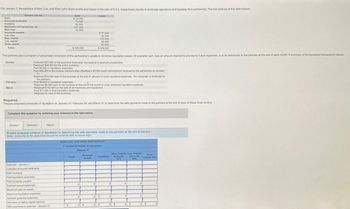Required: Prepare proposed schedules of liquidation on January 31, February 28, and March 31 to determine the safe payments made to the partners at the end of each of these three months.
Required: Prepare proposed schedules of liquidation on January 31, February 28, and March 31 to determine the safe payments made to the partners at the end of each of these three months.
Financial Accounting
14th Edition
ISBN:9781305088436
Author:Carl Warren, Jim Reeve, Jonathan Duchac
Publisher:Carl Warren, Jim Reeve, Jonathan Duchac
Chapter12: Accounting For Partnerships And Limited Liability Companies
Section: Chapter Questions
Problem 4PB
Related questions
Question
None

Transcribed Image Text:On January 1, the partners of Mori, Lux, and Khan (who share profits and losses in the ratio of 53.2, respectively) decide to terminate operations and liquidate their partnership. The trial balance at this date follows:
General Journal
Cash
Accounts receivable
Inventory
Debit
$24,000
Credit
Machinery and equipment, net
Mori, loan
Accounts payable
Lux, loan
Mori, capital
Lux, capital
Khan, capital
Totals
78,000
64.000
227,000
42,000
$77,000
32,000
124,000
$409,000
96,000
80.000
$409,000
The partners plan a program of piecemeal conversion of the partnership's assets to minimize liquidation losses. All available cash, less an amount retained to provide for future expenses, is to be distributed to the partners at the end of each month. A summary of the liquidation transactions follows:
January
February
March
Collected $57,000 of the accounts receivable, the balance is deemed uncollectible
Received $44,000 for the entire inventory
Paid $8,000 in liquidation expenses
Paid $66,000 to the outside creditors after offsetting a $9,000 credit memorandum received by the partnership on January
11.
Retained $16,000 cash in the business at the end of January to cover liquidation expenses. The remainder is distributed to
the partners
Paid $9,000 in liquidation expenses.
Retained $4,000 cash in the business at the end of the month to cover additional liquidation expenses
Received $152,000 on the sale of all machinery and equipment
Paid $11,000 in final liquidation expenses.
Retained no cash in the business.
Required:
Prepare proposed schedules of liquidation on January 31, February 28, and March 31 to determine the safe payments made to the partners at the end of each of these three months.
Complete this question by entering your answers in the tabs below.
January
February
March
Prepare proposed schedule of liquidation to determine the safe payments made to the partners at the end of January
Note: Amounts to be deducted should be entered with a minus sign.
MORI, LUX, AND KHAN PARTNERSHIP
Proposed Schedule of Liquidation
Balances January 11
Collected accounts receivable
Sold inventory
Paid liquidation expenses
Paid accounts payable
Subtotal (actual balances)
Maximum loss on assets
Maximum liquidation expenses
January 31
Mori, Capital Lux, Capital
Cash
Noncash
Assets
Liabilities
and Loan
and Loan
50%
30%
Khan,
Capital 20%
0
0
이
Subtotal (potential balances)
0 $
0
0
0
Allocation of deficit capital balance
Safe payments to partners - January 31
OS
0 $
05
0 $
0 $
0
Expert Solution
This question has been solved!
Explore an expertly crafted, step-by-step solution for a thorough understanding of key concepts.
This is a popular solution!
Trending now
This is a popular solution!
Step by step
Solved in 5 steps

Knowledge Booster
Learn more about
Need a deep-dive on the concept behind this application? Look no further. Learn more about this topic, accounting and related others by exploring similar questions and additional content below.Recommended textbooks for you

Financial Accounting
Accounting
ISBN:
9781305088436
Author:
Carl Warren, Jim Reeve, Jonathan Duchac
Publisher:
Cengage Learning

College Accounting, Chapters 1-27
Accounting
ISBN:
9781337794756
Author:
HEINTZ, James A.
Publisher:
Cengage Learning,

Financial Accounting
Accounting
ISBN:
9781337272124
Author:
Carl Warren, James M. Reeve, Jonathan Duchac
Publisher:
Cengage Learning

Financial Accounting
Accounting
ISBN:
9781305088436
Author:
Carl Warren, Jim Reeve, Jonathan Duchac
Publisher:
Cengage Learning

College Accounting, Chapters 1-27
Accounting
ISBN:
9781337794756
Author:
HEINTZ, James A.
Publisher:
Cengage Learning,

Financial Accounting
Accounting
ISBN:
9781337272124
Author:
Carl Warren, James M. Reeve, Jonathan Duchac
Publisher:
Cengage Learning


